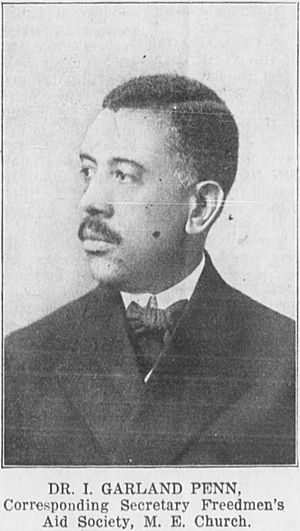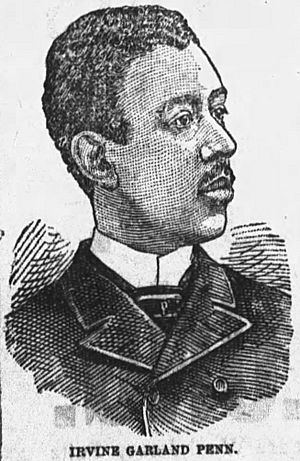Irvine Garland Penn facts for kids
Quick facts for kids
Irvine Garland Penn
|
|
|---|---|

Penn in 1913
|
|
| Born | October 7, 1867 |
| Died | July 22, 1930 (aged 62) |
| Alma mater | Rust College, Wiley College |
| Occupation | Educator, writer, journalist |
| Religion | Methodist |
| Signature |  |
Irvine Garland Penn (born October 7, 1867 – died July 22, 1930) was an important American educator, writer, and journalist. He was also a strong leader in the Methodist Episcopal Church. Penn wrote a famous book called The Afro-American Press and Its Editors in 1891. He also worked with other famous people like Frederick Douglass and Ida B. Wells on a pamphlet in 1893. Later in his life, he became a key figure in the Methodist Episcopal Church, working to support African Americans until he passed away.
Contents
Early Life and Education
Irvine Garland Penn was born on October 7, 1867, in a place called New Glasgow, Virginia. When he was about five years old, his family moved to Lynchburg, Virginia. He started working in the newspaper business even before he finished high school. He later earned a master's degree from Rust College in 1890. He then received a doctorate from Wiley College in 1908, showing his dedication to learning.
A Voice for Change
In 1886, Irvine Penn started working as a writer for several newspapers. These included the Richmond Planet, the Knoxville Negro World, and the New York Age. He often wrote about the lives and issues facing African Americans. In the same year, he became the editor of a small newspaper called the Laborer. By 1887, he was also a teacher in Lynchburg, and by 1895, he became the principal of the school.
Penn's writing became very well known. He often spoke out against unfair treatment and for the rights of African Americans. In 1891, he published his book, The Afro-American Press and Its Editors. This book shared the stories of many African American newspaper editors and journalists.
In 1893, Penn worked with famous leaders like Frederick Douglass, Ida B. Wells, and Ferdinand Lee Barnett. They wrote a pamphlet called The Reason Why the Colored American Is Not in the World's Columbia Exposition. This was part of a protest by African Americans against the 1893 Chicago Columbian Exposition. They were protesting because African American exhibits were kept separate.
Two years later, in 1895, Penn helped organize the African American exhibits at the Atlanta Cotton States and International Exposition. He was very important in choosing Booker T. Washington for a leading role at this event. This helped make Washington a nationally recognized figure.
Church Leadership
In 1897, Penn moved to Atlanta. There, he became an Assistant General Secretary for the Epworth League, which was a youth group within the Methodist Episcopal Church. He also created the National Negro Young People's Christian and Educational Congress. This was a big meeting for young African Americans focused on faith and education. He continued to teach at Rust College and wrote another book, The College of Life, in 1902.
In 1912, Penn moved to Cincinnati. He became a co-secretary for the Freedmen's Aid Society of the Methodist Episcopal Church. In this role, he often raised money for Methodist colleges. These included Rust University, Morgan College, and Philander Smith College. One of his biggest supporters was James N. Gamble, whose father helped start Procter & Gamble.
In the mid-1910s, Penn joined a movement to unite different Methodist churches in America. These churches had been separated partly because of disagreements over slavery. Penn and Robert E. Jones were key African American members of the group working on this unification. They worked to make sure the interests of black Methodists were heard.
In 1924, the Methodist Episcopal Church combined its black and white education boards. This change meant Penn was no longer the secretary for the Board of Education for Negroes. Even though his work faced some criticism, he remained a member of the new combined board.
Family and Later Years
Irvine Penn married Anna Belle Rhodes in 1889. She was from Lynchburg and had graduated from Shaw University. She also taught there for several years. Irvine and Anna Belle had seven children together.
Penn became very ill in Cincinnati in July 1930, just a few weeks after his wife passed away. He died on July 22, 1930, from heart disease. There is a belief that his death might have been connected to injuries he received when he was forced off a segregated train car in South Carolina.
Images for kids



